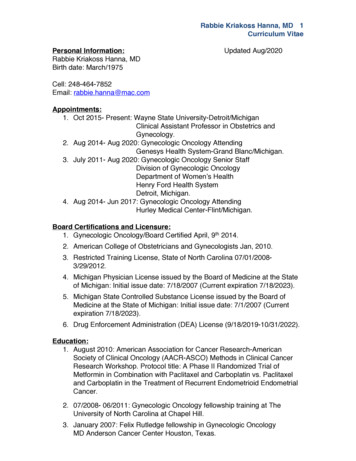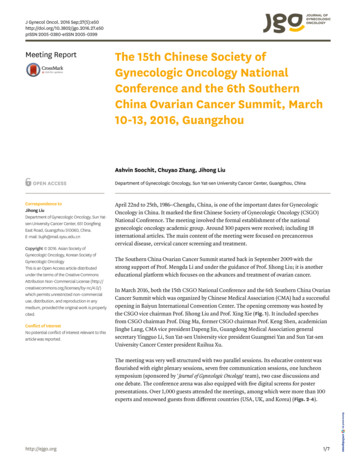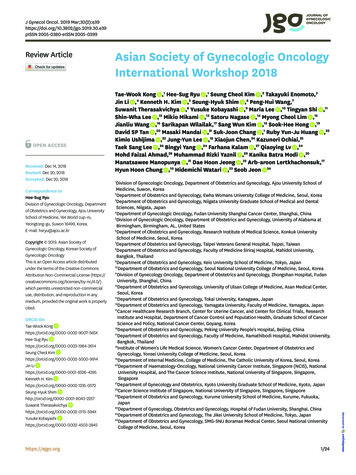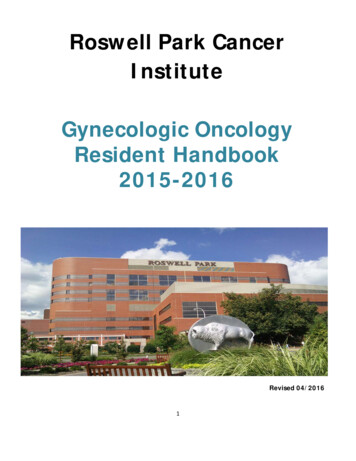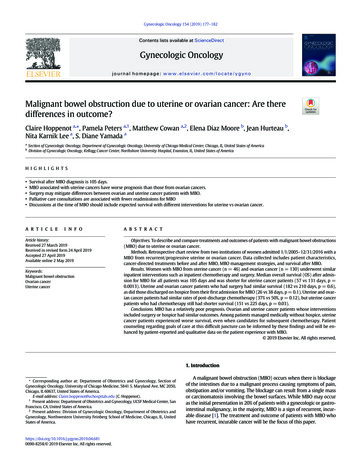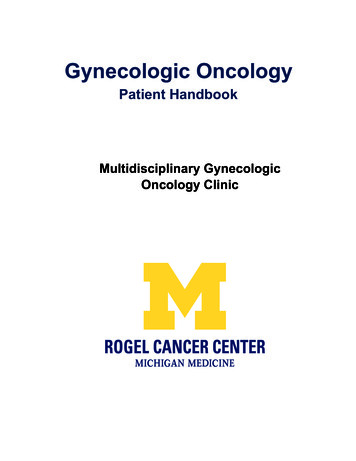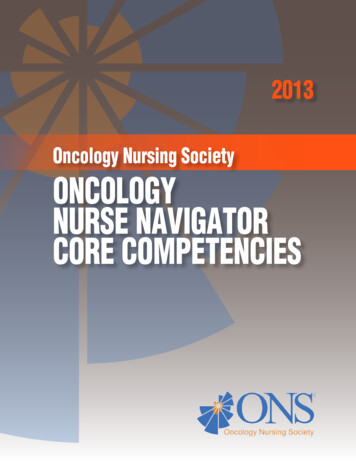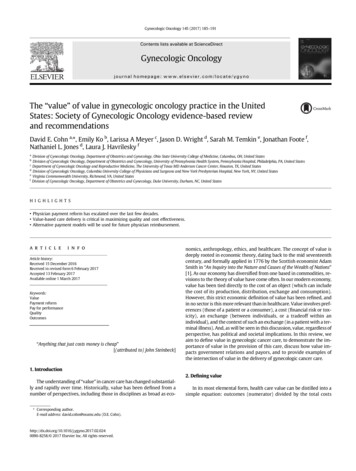
Transcription
Gynecologic Oncology 145 (2017) 185–191Contents lists available at ScienceDirectGynecologic Oncologyjournal homepage: www.elsevier.com/locate/ygynoThe “value” of value in gynecologic oncology practice in the UnitedStates: Society of Gynecologic Oncology evidence-based reviewand recommendationsDavid E. Cohn a,⁎, Emily Ko b, Larissa A Meyer c, Jason D. Wright d, Sarah M. Temkin e, Jonathan Foote f,Nathaniel L. Jones d, Laura J. Havrilesky faDivision of Gynecologic Oncology, Department of Obstetrics and Gynecology, Ohio State University College of Medicine, Columbus, OH, United StatesDivision of Gynecologic Oncology, Department of Obstetrics and Gynecology, University of Pennsylvania Health System, Pennsylvania Hospital, Philadelphia, PA, United StatescDepartment of Gynecologic Oncology and Reproductive Medicine, The University of Texas MD Anderson Cancer Center, Houston, TX, United StatesdDivision of Gynecologic Oncology, Columbia University College of Physicians and Surgeons and New York Presbyterian Hospital, New York, NY, United StateseVirginia Commonwealth University, Richmond, VA, United StatesfDivision of Gynecologic Oncology, Department of Obstetrics and Gynecology, Duke University, Durham, NC, United StatesbH I G H L I G H T S Physician payment reform has escalated over the last few decades. Value-based care delivery is critical in maximizing quality and cost effectiveness. Alternative payment models will be used for future physician reimbursement.a r t i c l ei n f oArticle history:Received 15 December 2016Received in revised form 6 February 2017Accepted 13 February 2017Available online 1 March 2017Keywords:ValuePayment reformPay for performanceQualityOutcomes“Anything that just costs money is cheap”[(attributed to) John Steinbeck]nomics, anthropology, ethics, and healthcare. The concept of value isdeeply rooted in economic theory, dating back to the mid seventeenthcentury, and formally applied in 1776 by the Scottish economist AdamSmith in “An Inquiry into the Nature and Causes of the Wealth of Nations”[1]. As our economy has diversified from one based in commodities, revisions to the theory of value have come often. In our modern economy,value has been tied directly to the cost of an object (which can includethe cost of its production, distribution, exchange and consumption).However, this strict economic definition of value has been refined, andin no sector is this more relevant than in healthcare. Value involves preferences (those of a patient or a consumer), a cost (financial risk or toxicity), an exchange (between individuals, or a tradeoff within anindividual), and the context of such an exchange (in a patient with a terminal illness). And, as will be seen in this discussion, value, regardless ofperspective, has political and societal implications. In this review, weaim to define value in gynecologic cancer care, to demonstrate the importance of value in the provision of this care, discuss how value impacts government relations and payors, and to provide examples ofthe intersection of value in the delivery of gynecologic cancer care.1. Introduction2. Defining valueThe understanding of “value” in cancer care has changed substantially and rapidly over time. Historically, value has been defined from anumber of perspectives, including those in disciplines as broad as eco⁎ Corresponding author.E-mail address: david.cohn@osumc.edu (D.E. 40090-8258/ 2017 Elsevier Inc. All rights reserved.In its most elemental form, health care value can be distilled into asimple equation: outcomes (numerator) divided by the total costs
186D.E. Cohn et al. / Gynecologic Oncology 145 (2017) 185–191(denominator) [2]. However the prioritization and designation of whatoutcomes are relevant may vary depending on one's perspective. Thereare a multitude of examples within gynecologic oncology where thevalue equation may shift based on whether the outcomes are framedby the societal, payor, provider, or patient perspective.2.1. Michael Porter's value propositionMichael E. Porter, a renowned Harvard Business School economist,has argued that “improving health and health care value for patients”is integral not only to controlling costs, but also to overall health care reform [3]. The definition and the demonstration of value as “health outcomes achieved per dollar spent” is a key component to Porter'sreformed value-based system [4].Porter argues that defining value as the goal, rather than “reducingcost, maximizing revenue, or providing every service,” is the essentialprinciple to delivering a high-value system [5]. Central to this idea isthe argument that to improve value, one has to improve outcomes;and to improve outcomes one must provide high-quality care. However,surrogate measures of quality, such as adherence to guidelines and patient satisfaction, do not accurately assess quality of care. In order totruly assess quality and improve value, the outcomes important toeach disease must be specifically defined and measured. Porter arguesthat “the absence of comprehensive and rigorous outcome and costmeasurement is arguably the biggest “weakness standing in the wayof health care improvement” [2].In an effort to define high quality outcomes, Porter developed anoutcome measures hierarchy, in which specifıc health outcomes aremulti-tiered and disease-specific. In oncology, the highest tier isassigned to survival, followed by functional status achieved, recoverytimes following treatment, effects of the treatment process on functionand quality of life, and sustainability of the cancer-free state. Similarly,improving cost measurement is critical to Porter's value framework,where costs are defıned based on a “cycle of care” for a given medicalcondition, sometimes involving periods of a year or more. In Porter'svalue-based system, the responsibility for outcomes and costs areshared by all participating providers for a given medical condition, regardless of rank or specialty.Ultimately, Porter argues, “Improving value requires either improving one or more outcomes without raising costs, or lowering costs without compromising outcomes, or both” [6]. Porter's strategic agenda for avalue-based health care delivery system includes six components: 1)Organization of care into disease-related integrated practice units; 2)Measurement of outcomes and costs for every patient; 3) Bundled payments for care cycles, 4) Integration of care delivery across facilities; 5)Expansion of services across geography; and 6) Building an enabling ITplatform. Recently, other definitions of value have been proposed thatfocus more directly on the balance between clinical benefit, toxicity,and cost in healthcare.3. Measurement of outcomes and perspective of valueCrucial to the dialogue on value-based care in oncology is the abilityto measure and compare outcomes and cost. In order to successfully accomplish this, standardized methods are essential. To this end, there arenational and international efforts to bring together stakeholders to define relevant and patient-centered outcome measures for specific disease sites. One notable example is the International Consortium forHealth Outcomes (ICHOM), which has brought together clinical expertsalong with patient representatives to develop minimum standard outcome-measures, with oncologic sets already developed for prostate (localized and advanced), breast, colorectal, and lung cancers [7,8].The patient perspective can add to the value equation and to thebroader dialogue surrounding value-based care in a myriad of ways, andcan be achieved by assessing patient reported outcomes (PROs, includingpatient symptom burden, quality of life measures and patient preferences), as well as patient centered outcomes such as financial toxicity.Similar to the situation with defining outcomes, what costs are included in the denominator may vary depending on one's perspective.For example, cost from a payor perspective might include all costs fora cycle of care for any particular medical condition [2]. Lost wages orproductivity from an affected patient or caregivers are notable additionsto cost analyses from a societal and patient perspective. Additionally,out of pocket costs for medical care is an important additional consideration from the patient perspective.The monumental shift from the focus on the volume of services delivered to value-based health care delivery is hindered by the challengeof defining and measuring outcomes that matter to patients [7]. Thenumber of clinical trials in oncology that have incorporated patient reported outcomes is low. However, when performed, such outcomescan influence the value assessment of new agents, even without overallsurvival benefit. Similarly, PROs are in the minority in standardizedquality metrics. For example, within the National Quality MeasuresClearinghouse, only 139/1958 (7%) of quality indicators are consideredoutcome-measures, and b 2% of quality indicators are specifically patient reported outcomes [7]. Given the challenges of uniformly measuring and reporting PROs, integration of electronic patient reportedoutcomes systems into practice is increasingly common, and has the potential to contribute to the assessment of value in oncologic care [9].Likewise, increased efforts to include relevant patient centered outcomes in clinical trials have the potential to greatly influence value assessments for cancer therapies. In a health care environment whereresources are limited, understanding patient preferences can help organizations understand how to organize cancer care delivery to meet thechallenges of delivering high value and patient-centered care. Continued movement towards the categorical incorporation of patient reported outcomes, preferences and perspectives into the metrics of qualityand cost will ultimately drive and shape the value discussion forwomen with gynecologic malignancies and ensure alignment with thegoals of patient-centered care.3.1. ASCO value frameworkIn the United States, cancer is ranked second among the most expensivediseases to treat [https://meps.ahrq.gov/data files/publications/st331/stat331.shtml]. As a high proportion of health care expenditure occurs inoncology, and with an increasing proportion of cost incurred to patientsas direct out of pocket co-payments or shared-payment plans, cancer patients are increasingly experiencing financial toxicity [10]. This increasingfinancial burden for cancer patients has resulted in a lower quality of life,impedance of access to the highest quality care, and an increasing rate ofbankruptcy [10,11]. Evidence suggests that cancer patients want not onlyinformation regarding the effectiveness of available treatments, but also information on their relative costs [12,13].In 2007, the American Society of Clinical Oncology convened its firstValue in Cancer Care Task Force (formerly Cost of Cancer Care TaskForce) to address the issue of the rising costs of cancer care. In 2009,ASCO released a guidance statement with the following recommendations: “(1) recognition that patient-physician discussions regardingthe cost of care are an important component of high-quality care; (2)the design of educational and support tools for oncology providers topromote effective communication about costs with patients; (3) andthe development of resources to help educate patients about the highcost of cancer care to help guide their decision making regarding treatment options” [14].In 2015, ASCO presented a value framework “for comparing the relative clinical benefit, toxicity, and cost of treatment in the medical oncology setting”; and to “provide a standardized approach to assistphysicians and patients in assessing the value of a new drug treatmentfor cancer as compared with one or several prevailing standards ofcare” [15]. The framework was designed to assess the relative value of
D.E. Cohn et al. / Gynecologic Oncology 145 (2017) 185–191novel therapies based on outcomes published in phase III randomizedcontrolled trials. ASCO envisioned this framework as a physician-guidedtool not only to assess the relative value of a treatment, but also to aid inshared-decision making with patients. In May of 2016, ASCO presenteda revised value framework following a period of public comment [16].There are two versions of the value framework, the advanced diseaseand the adjuvant/curative framework. The advanced-disease framework is best suited to assessing the relative value of treatments, for example in a case of newly diagnosed advanced or recurrent ovariancancer, and consists of six measurable aspects of treatment used to calculate the Net Health Benefit (NHB) of a novel therapy compared to astandard of care: 1) clinical benefit based on improvement in overallsurvival (OS), progression-free survival (PFS), or response rate (RR);2) toxicity; 3) probability of long-term survival; 4) palliation of cancer-related symptoms; 5) quality of life (QOL); and 6) treatment-freeinterval (TFI). The ASCO task force has assigned relative importanceweights to each of these aspects, as well as to each component of clinicalbenefit (OS, PFS, and RR). The maximum possible NHB score for the advanced disease framework is 180 points; with the following possibletotal points for each aspect of the framework: 1) clinical benefit 100 points; 2) toxicity 20 to 20 points; 3) long-term survival 20 points; 4) palliation of symptoms 10 points; 5) QOL 10 points;6) TFI 20 points. For each component of clinical benefit, ASCOassigned the following importance weight multipliers: OS, 1; PFS, 0.8;and RR, 0.7. After calculating NHB for a given novel therapy versus astandard of care, a value snapshot is used to graphically illustrate theimprovement in clinical benefit, the difference in toxicity, and theNHB score of a novel therapy over a standard therapy. Alongside theNHB, the value snapshot compares the drug-acquisition cost (and, ifavailable, the patient's out of pocket cost) per cycle of the novel therapyversus the standard therapy. The second framework is directed at adjuvant therapy, and incorporates similar principles as the advanced disease framework above, but in a more abbreviated algorithm. It alsoderives an overall Net Health Benefit score [16]. Examples of the ASCOvalue framework relative to ovarian cancer are presented later in thisdocument.4. New models of healthcare delivery4.1. Accountable care organizations (ACOs)ACOs were designed to align patient centered care with value basedcare. Introduced in 2010, ACOs attempt to incentivize high-value careusing the following key principles: (1) coordination of care through integrating services and (2) providing financial incentives for cliniciansand hospitals that efficiently manage patient care. Providers who joinACOs assume responsibility for patient outcomes and share savings ifquality and cost benchmarks are met as measured by quality metricsthat are reported to CMS annually. In 2015, N400 ACOs had been createdserving 7.2 million beneficiaries. Results to date are mixed – in 2012, 52of 220 ACOs were able to meet quality benchmarks and budget aries]. Sustained participation with ACOsaccepting shared financial risks may be a challenge as new models continue to be tested.The ACO structure is primarily a primary care model, but its extension to oncology care is expected. The oncology ACO has the potentialto standardize care pathways, integrate care, and improve patient/provider communication and patient education [17]. An analysis of cancerpatients included in the Physician Group Practice Demonstration(PGPD) from 2005 to 2010 suggests that an oncology ACO model mayimprove the value of care provided. Decreased spending (primarily inacute care settings) without changes in mortality were observed [18].Additionally, health insurance plans have teamed with health systemsin piloting oncology ACO programs [19].1874.2. Oncology Patient Centered Medical Home (OCPMH)The OCPMH is another model of care designed to improve cancercare delivery efficiency and value. In this model a comprehensiveteam of providers (e.g. oncologist, pharmacists, nurses, primary carephysicians) coordinate sustained care for a per beneficiary per monthfee [20]. Reductions in hospital admissions, emergency room visitsand length of stay have been demonstrated [21,22].5. The future of physician payment reform: shifting reimbursementHealthcare in the United States is most commonly reimbursed underthe fee-for-service model, which incentivizes procedures and interventionsthat are typically more highly reimbursed and provides little or no reimbursement for services such as patient education and teaching, service coordination, and lifestyle modification. This strategy can promote overuseof unnecessary interventions and underuse of other evidence-based strategies that are not rewarded [19]. The Affordable Care Act (ACA) contains numerous provisions that directly address how health care is organized,delivered, and paid for in the United States. Shifting the focus of healthcare from volume to value is a central pillar of the ACA. Improving valueby increasing efficiency and decreasing the high cost of a predominantlyfee-for-service system is a central initiative. The ACA anticipates the realization of this goal by: (1) shifting from a reimbursement system based on thevolume of services provided to one based on the value of care; and (2) testing new models of health care delivery.Although quality and cost are often thought to increase in parallel, itis important to remember that low quality care can be very expensive,and high quality care can be delivered at low cost; quality and cost arenot mutually exclusive. Tying physician payments to the quality ofcare provided is an overarching goal of the ACA. The Department ofHealth and Human Services (HHS) aims “to have 30% of Medicare payments tied to quality or value through alternative payment models bythe end of 2016 and 50% of payments by 2018” [23]. Physician paymentsare being modified so that those who provide higher value care will receive higher payments than those who provide lower quality care.The most common methods to reform fee-for-service have focusedon pay-for-performance (P4P) programs. These programs provide payment incentives when the care that is rendered meets a specified goaland, alternatively, may result in a penalty or disincentive if certain targets are not met. P4P initiatives are meant to promote high qualitycare and align the goals of care across physicians and hospitals [19].The Centers for Medicare and Medicaid Services (CMS) has developed and tested a number of P4P programs over the last decade. ThePhysician Quality Reporting System (PQRS) program requires physicianreporting of specific quality metrics; it was initially associated with incentives and now also includes penalties irect /pqri]. The electronic health record incentive program (“meaningful use”, MU) was instituted in 2011 as a part of theAmerican Recovery and Reinvestment Act (ARRA) to promote use ofelectronic health records and has a number stages that require more sophisticated use of electronic health records slation/EHRIncentivePrograms/index.html?redirect /ehrincentiveprograms] [24]. Finally, the PhysicianValue-Based Payment Modifier (PVBM) program is an initiative stemming from the ACA that adjusts Medicare reimbursements and aimsto improve value by rewarding both higher quality and reduced grams/Value-Based-Programs.html].6. Medicare Access and Children's Health Insurance Program (CHIP)Reauthorization Act (MACRA)The development and implementation of financial rewards to physicians who provide value-based health care is ongoing through changes
188D.E. Cohn et al. / Gynecologic Oncology 145 (2017) 185–191to Medicare reimbursement strategies. In April 2015, passage of theMedicare Access and CHIP Reauthorization Act (MACRA) repealed thelong-standing, unsuccessful Sustainable Growth Rate (SGR) formulafor Medicare and sunset the PQRS, Value-based Payment Modifier andMeaningful Use of Electronic Health Records programs for physicians.In their place, CMS put in annual updates to the money available fromMedicare to pay physicians and two value-based payment alternativesthat physicians need be in to avoid payment penalties 16-VM-Fact-Sheet.pdf]. Under MACRA, now known as theQuality Payment Program (QPP), CMS will collect data from physicianservices in 2017 with payment adjustments being made based uponthis data starting in 2019. One of the value-based payment alternativesunder the QPP is the Merit-based Incentive Payment System (MIPS),which looks very similar to the existing federal quality loads/2016-VM-Fact-Sheet.pdf].6.1. Merit-based Incentive Payment System (MIPS)MIPS is a fee-for-service–based program with reporting beginning in2017 with payment adjustments in 2019 linked to a composite score ofquality, resource use, clinical improvement, and the use of technologyincluding EHR. In large part, MIPS is a modification of P4P programsand incorporates elements of PQRS, MU and PVBM. Initial adjustmentsof 4% (either positive or negative) based on performance will increaseto 9% in 2022. In addition, during the first six payment years of the program (2019–2024), MACRA allows for up to 500 million each year inadditional positive adjustments for exceptional performance. The overall program is designed to be budget neutral, so provider bonuses willbe offset by provider penalties. It is believed that most clinicians will initially participate in MIPS.The Centers for Medicare and Medicaid have announced that thefirst year of reporting, 2017, physicians will be able to “Pick their OwnPace,” for reporting. If a physician was ready, he or she could havebegan collecting performance data on January 1, 2017. For those whowere not ready on January 1, start can be anytime before October 2,2017; regardless of the start date, performance data must be sent byMarch 31, 2018. If a physician chooses not to report anything, theywill receive a 4% negative adjustment to their Medicare reimbursements in 2019. If a physician chooses to submit something in 2017 (information on a single quality measure or clinical practice improvementactivity), the negative payment adjustment will not be applied. If a physician chooses to submit more quality, clinical practice improvement,and electronic health record information (now known as AdvancingCare Information), they will qualify for various bonus pools, dependingon how much they report. The quality domain will rely on reporting ofsix measures from a range of options that vary across specialties andpractices. In the first year of roll out quality will account for 60% of thetotal MIPS score. Advancing care information is a measure that reflectshow physicians use technology in their daily practice. This measurehas a particular emphasis on information exchange and is not merelya measure of EHR use. Advancing care information will account for25% of the total MIPS score in the first year. Clinical practice improvement activities are meant to incentivize actions that enhance qualityof care, including coordination of care, patient engagement and safety.A list of 90 potential options are available to fulfill this metric.Clinical practice improvement activities will account for 15% ofthe total MIPS score in year one. Finally in the first year, cost ofcare will contribute 0% to the total score. However in subsequentyears, it will be at 10%, increasing over time to 30% of the totalMIPS score. This metric is based on Medicare claims data of 40 episode-specific measures ernizing-howmedicare-pays-physicians.html].6.2. Alternative payment models (APMs)CMS is promoting a number of novel alternative payment models(APMs) aimed at reducing unwarranted expenditures and improvingquality. As defined by MACRA, APMs include programs through the 1)CMS Innovation Center Model; 2) Medicare shared Savings Program3) Demonstration under the Health care Quality Demonstration Program and 3) Demonstration required by federal law [at https://qpp.cms.gov/learn/apms]. Types of programs include accountable care organizations (ACOs), advanced primary care medical homes, and bundledpayments. It is estimated that approximately 20% of Medicare fee-forservice expenditures currently are distributed through some type ofAPM. The goal is to increase APMs to 30% by 2016 and 50% by 2018[CMS.gov Centers for Medicare and Medicaid Services].Ultimately under the QPP, physicians may choose to participate inthe MIPS pathway or the Advanced APM. The advanced APM has multiple requirements including the following: 1) Use of certified electronichealth records (EHR) technology whereby 50% of eligible clinicians inthe APM entity use the CEHRT in year one with an increase to 75% ofphysicians using in the year after, 2) payment based on quality measures comparable (as defined as any actual MIPS measure that are evidence-based, reliable and valid) to those in the MIPS qualityperformance category (with at least one outcome measure), and 3) either requires APM entities to bear more than nominal financial risk formonetary losses or is a Medical Home Model expanded under CMMI(Center for Medicare and Medicaid Innovation) authority. If a physicianparticipates in an advanced APM and sees sufficient patients within theAPM, then he/she can be exempt from the MIPS program.Physicians participating in “Advanced APMs” are excluded fromMIPS, eligible for bonuses initially (5% lump sum bonus applies in2019–2024, in addition to the shared savings or shared losses of theAPM directly) and then potentially increased reimbursement in yearsthereafter [19], assuming they meet the criteria to be a “qualified provider” in that Advanced APM. A Qualified Provider status is defined byCMS as someone who receives 25% of Medicare Part B paymentsthrough an Advanced APM or sees 20% of Medicare patients throughan Advanced APM.The underlying principle of episode-based, bundled payment is tolink the payment of services by providers, hospitals and other facilitiesthat occur during a given episode of care or intervention. By linking payments there is an incentive to provide value and minimize waste andutilization of unnecessary services. Through a bundled payment, providers and systems that can most efficiently allocate resources and provide high quality care will be rewarded [CMS.gov Centers for Medicareand Medicaid Services]. The potential up-side and down-side of participating in an Advanced APM ultimately depends on an organization's financial structure, strategy for accepting risk, thresholds for acceptablerisk for monetary losses, patient and types of payor distributions. For example, if an Advanced APM has significant downside risk that includesboth Part A (inpatient/hospital) and Part B (physician) services, thecombined risk may be greater than the maximum negative MIPS adjustment which is only applied to Part B services. The organization mayneed to pay CMS a large sum, particularly if they do not meet the setquality benchmark for that Advanced APM. Alternatively, if an organization meets the QP status, thus receiving the 5% incentive payment, thatmay exceed or at least offset the relative Part A/Part B payment. Similarrisk structures would apply to programs contracted with commercialpayors if designed in similar manner with two sided risk. Ultimately,the organization (hospital and providers) would carry the burden of potential financial penalty if they do not meet set thresholds or if renderedservices exceed the sum allotted for care plus any included bonuses forparticipation.A number of bundled payment models have been developed from avariety of sources including collaborations with physicians that are currently undergoing evaluation [19,25,26]. The CMS has begun testing 3bundled payment models: Bundled Payments for Care Improvement
D.E. Cohn et al. / Gynecologic Oncology 145 (2017) 185–191(BPCI), the Comprehensive Care for Joint Replacement (CCJR) Model,and the Oncology Care Model (OCM) [25]. While all of the models differin certain aspects, the underlying principle is that services around a defined period of time are bundled and a single organization is accountable for the care that is rendered [CMS.gov Centers for Medicare andMedicaid Services]. The CCJR program encompasses Medicare beneficiaries who undergo hip or knee replacement and is the first mandatorybundled payment program [25,26]. The CCJR program captures carefrom the time of hospitalization for joint replacement until 90 daysafter discharge [25].The OCM program provides an APM for cancer patients receivingchemotherapy. The episode of care begins when a patient initiates chemotherapy and spans the following 6 months. It encompasses all carethat is rendered including physician costs, facility charges, drug charges,laboratory and radiology charges and end of life care. The OCM programbegan in 2016 and contains a number of quality reporting requirementsaimed at reducing unnecessary care rmancemethod-slides.pdf]. Participating oncologistsreceive a monthly care management fee to reward coordinated carethat reduces unnecessary testing and hospitalizations. Additionalbonus payments are possible for practices that meet cost and qualitytargets [25]. ASCO has developed a program that relies on several oft
States: Society of Gynecologic Oncology evidence-based review . d Division of Gynecologic Oncology, Columbia University College of Physicians and Surgeons and New York Presbyterian Hospital, New York, NY, United States . dating back to the mid seventeenth century, and formally applied in 1776 by the Scottish economist Adam .
